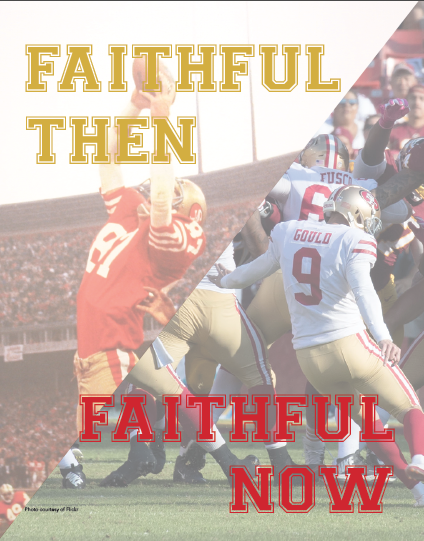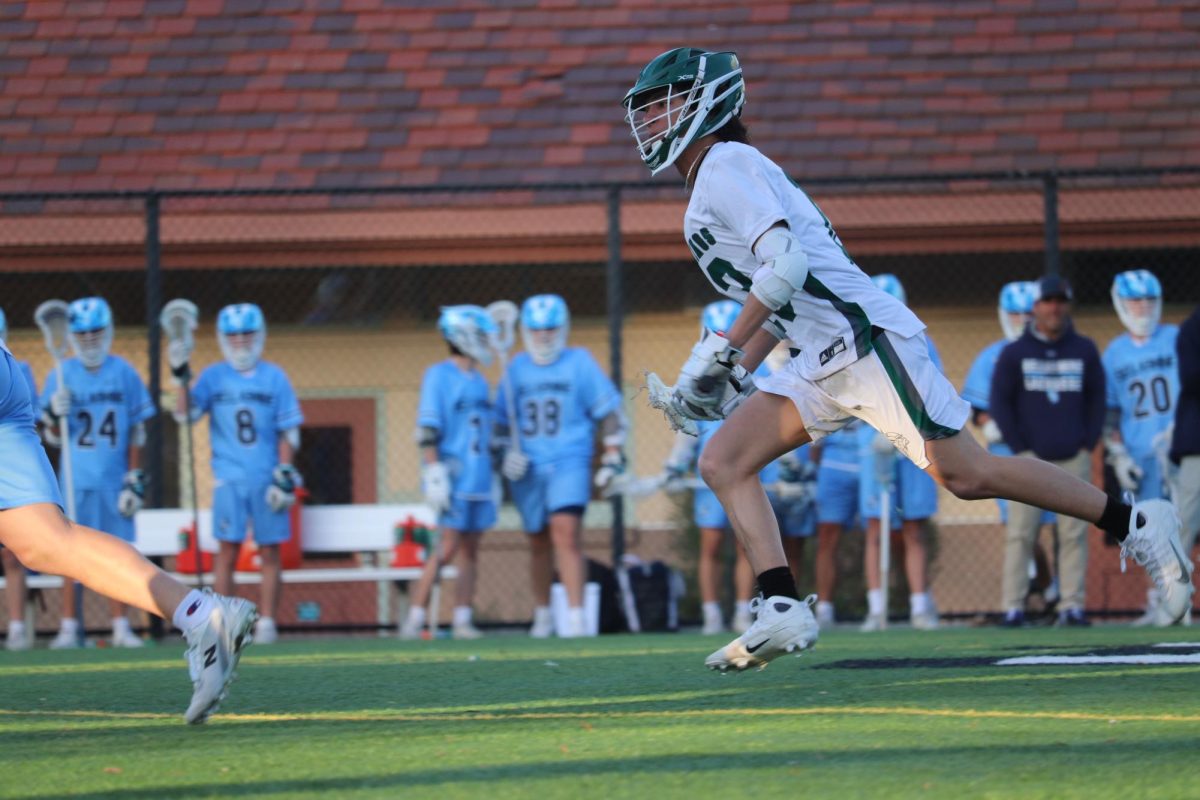Faithful Then, Faithful Now
Founded in 1946, the San Francisco 49ers have seen their share of successes and failures. Millions of fans passed through Kezar, Candlestick, and Levi’s Stadium to watch their favorite team play. One of those fans was Robert Bliss. Born in 1932, the San Francisco native quickly became enthralled with the young 49ers franchise, developing a lifelong passion. I sat down with Bliss, my grandfather, as he recounted how his fandom has stayed with him throughout his life, and how it shaped himself and our family.

January 9, 2020
A faded gold-colored bomber jacket that has started to fray envelops my grandfather, Robert Bliss. The words “FORTY NINERS” that are stitched into the iconic satin in varsity lettering don’t appear particularly noteworthy in the sea of red and gold, but bought and worn since 1976, these letters have walked in and out of Candlestick and Levi’s Stadium, wrapped around this dedicated fan for over 40 years.
“I missed two seasons in the military, and I went to two weddings,” my grandfather tells me. “The rest of the time I went to every game.”
Even while he was serving with the US Marine Corps in Korea from 1951 to 1952, he kept up with his favorite team. “My mother would send me articles about the 49ers in Korea,” he recounted.
My grandfather got his first season ticket when he returned from war for the 1953 season. He has had tickets ever since, a constant presence in the rows of 49ers fans.
When he became a fan in 1946, the times were very different. Born and raised in San Francisco, the football games at Kezar Stadium were very accessible to him.
“[Going to games] cost 25 cents with a student body card,” he said. “The next year cost 50 cents with a student body card
. Next year it cost 75 cents with a student body card.”Back in the early years of the franchise, the 49ers were members of the All-American football conference. The league consisted of the New York Yankees, the Brooklyn Dodgers, the Buffalo Bisons, the Chicago Rockets, the Cleveland Browns, the San Francisco 49ers, the LA Dons, and the Miami Seahawks.
“[It was] the most exciting football I’ve ever seen, because they could do things you couldn’t do now,” my grandfather said. “[It was] lots of fun. The players were smaller and weren’t as fast, but they were exciting as heck.”
The modern game, with spread formation, RPO’s, and many more points on the scoreboard, doesn’t stop him from enjoying watching his team perform.
“This team is exciting, but it’s not the most exciting,” he says. “It’s on the list of the Top 10 exciting teams.”
It seems that nothing can top his favorite team ever, the Joe Montana led 1981 Super Bowl team, whose legendary “Catch” against the Dallas Cowboys marked one of the greatest plays in NFL history.
Growing up and spending so much time with the 49ers has left my grandpa not only with memories of incredible plays, but with unique, peculiar anecdotes.
In 1949, the 49ers made an effort to increase their profits, trying to curb the amount of student-discounted tickets sold and increase the number of full-paying adults in attendance. In a playoff game against the New York Yankees, my grandfather recalls them sending all high schools students to a separate entrance gate from the regular attendants.
“We had 3,000 kids pushing on the gate and the half inch metal chain popped and the gates swung open and we ran in,” he remembered. “I sat on the New York Yankees bench during the game. Surrounding the field, were six, eight feet wide of kids all the way around the field.”
At this point in our interview, my dad, also named Robert Bliss, interrupts, asking if security tried to kick the students off the field.
“Well they tried to chase us off but it was like chasing off flies,” he said. “We weren’t being bad. We were just watching the game. I sat down on the New York Yankees bench and the cop chased me away. And after he left, I came and sat back down, two of the New York Yankee players said, ‘We got a new team member.’ I remember that. We won the game.”
In the early fifties, the 49ers used to practice at St Mary’s College in Moraga, California, so my grandfather and his mother would go to the college to watch them play.
“I knew Bob St. Clair slightly from high school,” he tells me. “And so Bob St. Clair was playing and I’m sitting there and a horse reaches over.”
He goes on about the horses.
“I reach up and I’m scratching the horse and the other horse does the same thing,” he tells me.
He gets to the part of the story that always made me laugh as a kid. “So here I’m sitting leaning against the fence, scratching these two horses heads and Bob St. Clair looks over says ‘I know you don’t I?’ and I said ‘Hi Bob’,” he said chuckling.
Scattered throughout the stories he tells me is Leo Nomellini, an unusual favorite among Niners Empire whose idols have been legends like Jerry Rice and Joe Montana. My grandfather mentions him over and over, painting him as one of his favorite 49ers players of all time. As he remembers watching him play, his eyes light up at the memory. When I mention this in our interview, he begins telling me about him.
“He was 6’3” and weighed 273,” he says. “In those days that was big, and he had long arms and a great balance.”
Watching Nomellini play reminded him of an old childhood fantasy.
“I’d just sit there and watch him because I wanted to be offensive or defensive tackle as a kid,” he said. “I wasn’t anything near like that though.”
Whilst a lack of natural talent unfortunately meant that professional football wasn’t a career option for him, time passed and my grandfather grew up, got a job, and lived his life.
The world changed around my grandfather, the only constant was his dedication to the San Francisco team. He started a family, one that was quickly exposed to his love for football, namely the 49ers franchise. As he raised his children, he passed on the tradition of attending 49er home games to his son, my dad.
For the entirety of my father’s youth, going to the games was a major commitment. They were living outside of rural Merced in Central California, at the time which meant that the commute to Candlestick Park was often longer than the game itself.
“It’d be all day: three hour plus drive up, three hour drive back,” my dad recalls. “So if the game was a one o’clock game we’d leave at like 9.”
The immense time commitment brought the two together.
“We used to talk history and all kinds of stories like that,” my grandfather jumps in, reminiscing. “I enjoyed driving up more than I enjoyed the games.”
“[The 49ers have] been something that I bonded with [my] dad over my whole life,” my dad tells me.
That’s what the 49ers are for our family: a chance to come together over a shared love for football and the people who we watch it with.
What does it mean to him to have us all there with him?
“A great deal,” he says.
To us too. 49ers games have been a favorite tradition of ours for as long as I can remember. Every home game, we pile together our buckets of franchise merchandise, t-shirts, blankets, beanies and jackets, decking ourselves out in gear to support our team.
“I’ve really appreciated that you guys have shown interest, because for me, it was a really fun part of growing up,” my dad tells me. “A big part of my childhood was being able to root for the niners and go to the games with [my] dad.”
When my brother and I were old enough to join the fandom, my grandfather got a third ticket so that we could go to games with him and my dad.
But with four avid niners fans in the family and just three tickets, my brother and I are often left divvying up the season so that we each get to go to games.
“I would like to have more tickets so I could take you all to the game,” my grandfather says. “I wanted to have some of you kids going to the game so I made sure I bought another ticket.”
My grandfather has been a 49ers fan for the entirety of his life. He passed down his love two generations: my father, my brother and I.
His iconic bomber jacket will always remind me of more than just the team. I literally grew up in that jacket.
I started watching football snuggled under the satin 49ers logo. When I was little, my grandfather would wrap me in it when I got cold. I pranced around in a jacket that went down to my knees, my arms never reaching the end of sleeve.
The original satin gold bomber that wrapped me as a child has a cultural notoriety among 49ers fans. These rare jackets have gone for hundreds on resale, but there’s no price for loyalty. These jackets have been passed down generations, creating a visible community of original Faithful.
The lifelong commitment to a team is the most respected achievement among fans. Often, my grandpa will be hollered at or stopped as fellow fans recognize him in his bomber, never hesitant to show their admiration.
Sometimes, like at a Christmas Eve dinner a couple years back, this community will materialize outside of the stadium and football area. Having seen my grandfather’s 49ers bomber jacket, a fellow fan walked over to the table to introduce himself. He stayed for 15 minutes, talking about their memories of the team.
Despite this lifelong commitment to the team and the frequent encounters with other fans because of his jacket, my grandfather humbly denies that he is a “special” fan. In fact, he told me that the only thing differentiating him from the crowd is the fact that he has been there longer than almost everyone else.
But this is far from the truth, in my opinion. I have seen the meager crowds during the losing years at Levi’s Stadium. I have watched the crowd swell on good years and shrink significantly on bad years, even within my short lifetime. It takes a strong character to stick with a team, through the lowest of lows and the highest of highs, for 70 long years.
It is because of him that my father, my brother and I gather around the TV at night during away games and spend time as a family.
I think all of that makes Robert Bliss a special fan.











